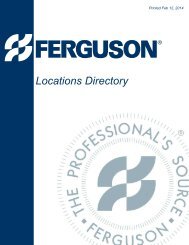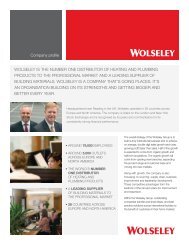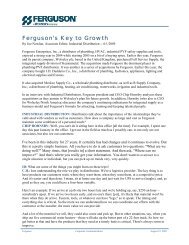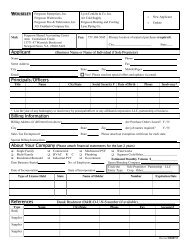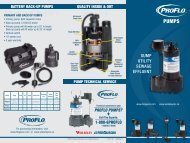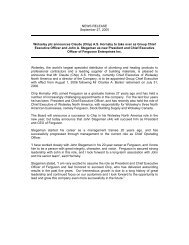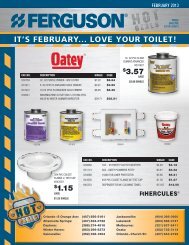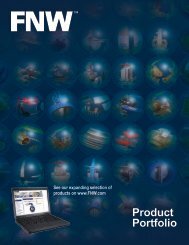THE KING OF THE HILL THE KING OF THE HILL - Ferguson ...
THE KING OF THE HILL THE KING OF THE HILL - Ferguson ...
THE KING OF THE HILL THE KING OF THE HILL - Ferguson ...
- No tags were found...
You also want an ePaper? Increase the reach of your titles
YUMPU automatically turns print PDFs into web optimized ePapers that Google loves.
FERGUSON ENTERPRISES INC.plumbing and builder products2 US BUSINESS REVIEW MAY 2005
CUSTOMER FOCUSED<strong>Ferguson</strong> Enterprises Inc. focuses on attracting and developing quality associates to providetop-quality service to its customers. —ALAN DORICHCLAUDE "CHIP" HORNSBY, PRESIDENT AND CEOof <strong>Ferguson</strong> Enterprises Inc., says that hiscompany is committed to its associates."By investing in their personal and professionaldevelopment, we're able to provideour customers with solutions and servicesbeyond what anyone else in the industrydoes today," he explains. "We have a simplephilosophy that we live by in our organization -- take care ofyour associates and they will take care of your customers."According to Hornsby, <strong>Ferguson</strong> works "to provide additionalservices beyond what anyone else in the industry does."Staffing its organization with quality associates is a toppriority, <strong>Ferguson</strong> says. The company adds that it invests atremendous amount of resources on recruiting, developing andtraining its associates."At <strong>Ferguson</strong>, we know that the quality of our people is themost valuable asset we can offer," Hornsbyexplains about <strong>Ferguson</strong>’s staff. "That's why werecruit them carefully, train them well and backthem up 100 percent in their efforts to providethe best service possible."The company, based in Newport News, Va., isone of three North American companies thatoperate under the umbrella of Wolseley NorthAmerica. Under Wolseley, <strong>Ferguson</strong> operateswith Stock Building Supply and WolseleyCanada. The company is a coast-to-coast wholesaledistributor that supplies residential andcommercial plumbing products, as well as builder products,such as lighting and appliances, and industrial pipe, valves andfittings. It also supplies heating and cooling equipment, waterworksproducts, and tool and safety products.Through its showrooms, trade counters and sales force,<strong>Ferguson</strong> serves a diverse mix of customers in businesses andindustries. These customers include plumbing, mechanical andwaterworks contractors, kitchen and bath dealers, builders,large industrial businesses, manufacturers and municipalities,as well as homeowners.Helping the CustomerFERGUSON BELIEVES IT HAS BUILT AN IMPECCABLE REPUTAtionwith its customers by stocking an inventory of parts andsupplies, as well as locating and delivering hard-to-find specialtyitems. "At <strong>Ferguson</strong>, we continually look for opportunitieswhere our excellence in distribution can contribute to our customers'bottom line," the company states.According to <strong>Ferguson</strong>, a great example of this is itsIntegrated Systems Division, which was created as a result ofPR<strong>OF</strong>ILE<strong>Ferguson</strong> Enterprises Inc.www.ferguson.com2004 sales: $6 billionHQ: Newport News, Va.Employees: 16,300Specialty: Plumbing andbuilder productsClaude “Chip” Hornsby, CEO:“At <strong>Ferguson</strong>, we know thatthe quality of our people isthe most valuable asset wecan offer.”trying to meet the needs of one of its customers. This divisiontakes on the task of procuring and warehousing supplies forentire manufacturing facilities. This way, the manufacturingfacilities are able to focus on its primary products.<strong>Ferguson</strong> says it must remain open and receptive to meetingthe changing needs of customers. "At <strong>Ferguson</strong>, we realizechange is inevitable," the company states. "That's why adaptabilityis such an important part of our corporate culture."Wolseley North America is part of Wolseley plc, which, thecompany says, is recognized as "the world's No. 1 distributorof heating and plumbing products" and a "leading supplier ofbuilding materials to the professional market." Wolseley isan international business operating more than 3,600 branchesin 13 countries, including the United States and Canada inNorth America.According to Wolseley, its strength involves operatingstrong national businesses in home markets, retaining localbrand superiority and continually exceedingcustomer expectations through its productoffering and service.Based on an entrepreneurial foundation,<strong>Ferguson</strong> was founded in 1953 by Charlie<strong>Ferguson</strong>, Ralph Lenz and Johnny Smithers,conducting business under individual names --Lenz Supply and Smithers Supply. The companystarted with two locations in Washington, D.C.,and Birmingham, Ala., with the purpose ofservicing small plumbing contractors.In 1954, a third location, Crossroads Supply,opened in Alexandria, Va. Crossroads served as the operatingcompany for all three locations. In 1959, the Peebles Supplydivision was opened in Newport News by David Peebles.Peebles would eventually become the second president of<strong>Ferguson</strong>, focusing on expanding the geographical footprint ofthe company.Under the leadership of Peebles, <strong>Ferguson</strong> says it achievedthe status of an industry leader by "idealizing the Americandream of owning and operating a business."Managers were recruited and hired with the opportunity toopen branch locations under their own names, structuringtheir businesses by basing them on the demands of local markets.Anticipating the need to provide well-trained resources tosupport continued growth, Peebles instituted a managementtrainingprogram, that was designed to "attract the best andbrightest the work force had to offer."In 1969, Peebles became president, changed the name of themanaging company to <strong>Ferguson</strong> Enterprises Inc., and discontinuedthe practice of naming locations after the managers thatopened them.▲US BUSINESS REVIEW MAY 20053
FERGUSON ENTERPRISES INC.plumbing and builder products<strong>Ferguson</strong> says that it looksfor opportunities where itsexcellence can contribute tothe customer’s bottom line.▲Peebles’ first official trainee would be Charlie Banks, whonow serves as group chief executive of Wolseley, headquarteredin the United Kingdom. Peebles continued the philosophy ofaggressive expansion.John Stegeman, COO of <strong>Ferguson</strong>, says Peebles also recognizedthe need to bring "entrepreneurial-type individuals" tothe company. "The biggest limiting factor is finding qualitypeople," Stegeman admits. "The need for quality trained peopleis paramount."In 1982, <strong>Ferguson</strong> was acquired by Wolseley plc. At this time,the company was a $142 million business with 76 locations in11 states.With Wolseley's financial strength, the company continuedto grow under the leader ship of Peebles. In 1989, Banks becamepresident of <strong>Ferguson</strong>, while Peebles was appointed chairman,before ultimately retiring in 1994. <strong>Ferguson</strong> believes that Banksis a testament to Peebles' foresight. According to the company,Banks' vision has served <strong>Ferguson</strong> well during its growth.Under the direction of Banks, <strong>Ferguson</strong> grew from $600million in sales to more than $3.3 billion, with 500 locations in38 states, as well as the District of Columbia, Puerto Rico andMexico. Under Banks' leadership, the company embarked on are-engineering program.With Banks as president, <strong>Ferguson</strong> was fast approaching abillion dollars in annual revenue. Banks realized that in orderto leverage this ever-growing organization and provide uniqueservices and capabilities to the customer, <strong>Ferguson</strong> was goingto have to restructure its current model.As a result, a supply chain model was developed that utilizeddistribution centers to improve service levels and fill rates tocustomers, and created efficiencies for its vendors. Along withrestructuring the company, <strong>Ferguson</strong> says that Banks set astandard for continual improvement and change.In 2001, Banks became group chief executive of Wolseley,while Hornsby moved into the positions of president and chiefexecutive officer at <strong>Ferguson</strong>.According to the company, Hornsby presides with a philosophyof "settling for nothing less than the best -- in productsoffered, in customer service provided and in the people whoare members of the <strong>Ferguson</strong> team." The company says thisphilosophy continues to be its competitive advantage today.Currently, <strong>Ferguson</strong>'s network covers more than 926 locations,and has an inventory investment of $1.2 billion. "Weoperate an internal delivery service, which moves material fromnine major distribution hubs to <strong>Ferguson</strong> branch locations andcustomers," the company explains.<strong>Ferguson</strong> has more than 16,000 associates and a delivery fleetof more than 3,000 vehicles. It also has locations in Barbados andTrinidad. In North America, Hornsby says that all three Wolseleycompanies did slightly more than $10 billion dollars in 2004."We announced that in the United States, <strong>Ferguson</strong> grew at arate of nearly 21 percent for the first half of this fiscal year,"Hornsby states.In terms of its growth, on average, the company says that ithas grown at a compound rate in excess of 17 percent per yearfor the past 25 years. At this rate, <strong>Ferguson</strong> states that it doubles▲4 US BUSINESS REVIEW MAY 2005
▲in size every 4.5 years. The company says that its entire managementapproach is geared towards using this growth “toattract, motivate and retain some of the best managementtalent in the business.”<strong>Ferguson</strong> says that its mission includes such principles ascontinually improving its performance, partnering withvendors that will help the company meet its customers' needsand becoming the premier customer-oriented supplier of valueaddedservices.Other important aspects of this mission include the companystriving to provide its associates with a work environment thatpromotes opportunities for personal growth and career development;to make a contribution to its communities as individualsand as a company; to succeed as a business; to provide a returnto its shareholders and to operate with integrity and achieve itsmission in an ethical manner.A Strong CompanySTEGEMAN SAYS FERGUSON IS <strong>THE</strong> LARGEST WHOLESALEplumbing distributor in the United States, as well as the"second- or third-largest waterworks and HVAC distributor."The heating and air conditioning business, still highly fragmented,provides the greatest opportunity for future growth,<strong>Ferguson</strong> says.An additional asset for the company, Stegeman says, isWolseley, the parent company of <strong>Ferguson</strong>. "They're in 13countries and exclusively in the distribution industry,"Stegeman declares. "<strong>Ferguson</strong> happens to be the largest companyWolseley owns, in terms of revenues.He also credits the company's work force,saying that <strong>Ferguson</strong> has people with a greatdeal of experience. "We have associates whohave grown up in this industry," Stegemanexplains, adding that these are individualswho have created and defined the company'sculture.He doesn't believe that any of the company'snational competitors spend as much time,energy or money on recruiting such talentedpeople. "We devote a significant amount oftime to hiring and training the right people,"he explains. "You don't just grow at the ratethat we're growing without making significantinvestments in recruiting and training."Stegeman is especially proud of the company'smanagement team, describing it as"extremely proactive.""It's a focused group of individuals workingin a unified direction," Stegeman explains."I consider that a huge strength."He cites the company's geographical platformas an asset for <strong>Ferguson</strong>, as well. "Witha new location scheduled to open in Maine,we'll have a presence in all 50 states," Stegemanexplains."The opportunity for us to grow marketshare -- regardless of whether the market isgrowing or not -- is dramatic," he explains.Core BusinessesJOHN WILCOX, WOLSELEY NORTH AMERICA SENIOR VICE PRESidentof alignment, explains how the concept of core businesseswas developed."When Chip Hornsby became president and chief executiveofficer of <strong>Ferguson</strong>, his executive team agreed it was time to segmentthe business by the four major customers it was serving atthat time," Wilcox explains, adding that these businesses wereresidential, waterworks, commercial/industrial, and heating andair conditioning."Executive vice presidents were assigned responsibility foreach area, which has resulted in greater focus to developingprograms for our customers and vendors," he states. Wilcoxnotes that it has also allowed the company to better leveragetalent and resources."The residential group contributes 40 percent of our sales,"Wilcox says. "We provide our building, remodeling and plumbingcontracting customers with products and services for the entireresidential spectrum -- from customer luxury to competitivetrack homes.""Our role is to serve as a liaison between contractor and endcustomerby guiding homeowners through the selectionprocess, while keeping in mind budgets and ease-of-installation,"the company says. "Products sold to this group are what we call'inside-the-wall' rough products like pipe, valves and fittings, aswell as ‘finished products’ like bath tubs, sinks and faucets."▲US BUSINESS REVIEW MAY 20055
FERGUSON ENTERPRISES INC.plumbing and builder products▲As it has grown, <strong>Ferguson</strong> says it has had to move away fromcities in order to acquire larger facilities and yards. "<strong>Ferguson</strong>Xpress is our vehicle for returning to the city to get back intouch with the small repair contractor," the company explains."Our strategy is to saturate high-population markets withmultiple locations, with 50 stores opening in fiscal year 2005and an additional 100 planned for fiscal year 2006.""<strong>Ferguson</strong> Xpress stores are stocked with frequently useditems with an emphasis on repair," <strong>Ferguson</strong> says. "Dailyreplenishment allows us to reduce inventory dollars and storesize, and also gives customers next-day access to any productstocked at the main distribution facility in that market.""Offering convenience, as well as consistent inventory andpricing throughout the city, positions us as the preferred wholesalesupplier for counter picks-ups for the small plumbingcontractor," the company adds.More than 85 percent of <strong>Ferguson</strong>'s showroom businesscomes from referrals of customers by the plumbing and buildingtrades. "To assist our contractor's customers in the selection ofproducts, we have created a network of showrooms called Bath,Kitchen and Lighting Galleries," the company explains."Depending on the size of the market, showrooms can range insize from 1,000 to 13,000 square feet," <strong>Ferguson</strong> states. "Our showroomsare staffed with professionally trained consultants, whoguide and assist contractors and designers and their customersin the selection of plumbing fixtures, lighting and appliances.""Frequently serving as extensions of the contractor's business,[the showrooms] offer a wide range of faucets, fixtures,lighting, appliances, fireplaces and accessories," the companysays. "But the real plus is product-knowledgeable associateswho have the capability to work with the homeowner and contractorto take the guesswork out of building and remodeling."<strong>Ferguson</strong> adds that roughly 25 percent of its sales are derivedfrom contractors or public institutions that fall into the commercial,industrial or mechanical group. The company specializes inproduct services like end-finishing, fabrication or actuation.The company's actuation capabilities include pneumatic,hydraulic and electronic automation of a majority of quarterturnvalves in the market. <strong>Ferguson</strong> says it accommodatesmulti-turn automation and maintains an inventory of preassembledvalves for quick delivery.The company adds it is also capable of valve modificationand a stock of accessories that include positioners, limit switches,bracketry and linkage. "Our state-of-the-art end-finishingfacilities operate 16 hours a day, five days a week to maintain alarge stock of cut, grooved, beveled or threaded stainless, carbonor copper for immediate delivery," <strong>Ferguson</strong> says. "Custom-endfinishing services are also available."Seventeen percent of <strong>Ferguson</strong>'s business is contributed bywaterworks contractors, land developers and municipalities.These customers purchase underground pipe, valves and fittingsthat are used for storm water management and water and sewersystems that ultimately support the infrastructure of the country.<strong>Ferguson</strong> says it has been in the waterworks business sincethe mid-1980s. "<strong>Ferguson</strong>'s resources and financial stability arecritical factors to success when dealing with the vast scope ofproducts typical for the industry," the company states. With▲Recruiting <strong>Ferguson</strong>'s FutureFERGUSON IS IN <strong>THE</strong> PROCESS <strong>OF</strong> RECRUITING MORE THAN 1,000college graduates this year. The company is committed torecruiting and developing new talent, in part because of itsrapid growth. <strong>Ferguson</strong> doubles in size every five years,Corporate Recruiter Krystle Costigan explains."We look at students at the entry level as being future managers,possibly even the CEO of our company," she says. "Weinvest our time and money and train them to be the best theycan be so after they've completed the training program, theystick with <strong>Ferguson</strong> as a career, not just a job."The program seems to be working - <strong>Ferguson</strong> boasts an 80percent retention rate.The company feels "it's very important to help studentsmake the right career decisions, whether it's with <strong>Ferguson</strong> ornot," Costigan emphasizes.Costigan has firsthand knowledge of the company's collegerecruitment process, because she recently went through itherself. She graduated from Radford University in Radford, Va.,in May 2004, majoring in marketing, with a minor in communications.She started working at <strong>Ferguson</strong> in August 2004."I came onboard and started in the warehouse - receiving awide variety of training and getting to know the company andcustomers from the ground up," she explains. "Then I moved tothe counter where I had my first face-to-face contact with ourcustomers. At <strong>Ferguson</strong>, we feel developing relationships withcustomers is an important aspect of our business. That's whywe feel our customers come back who have been with us five,10, 15 years, because of our personal touch, and it's becauseour customers are No. 1."Costigan then worked in the company's showroom assistinghomeowners, interior designers and architects select finishedproducts. She helped a range of customers, from those redoingtheir bathrooms to "someone building a $7 million home."She became a corporate recruiter in March. Her trainingtook six months, but it usually takes 12 to 18 months. Otherthan that, she says her path through the program was typical.Most trainees work in the warehouse and at the counter, andthen decide which areas they would like to enter, depending ontheir career path. "You pretty much determine your career pathand your success with <strong>Ferguson</strong>," she says.As a student, Costigan says she had never heard of <strong>Ferguson</strong>before. She kept seeing the company at career fairs and waspre-selected as a potential candidate. Costigan was invited toan information session via e-mail."The recruiter talked about how great the company was andwas so excited and had true passion for this company," shesays. "I was like, 'Wow, she is so excited about selling toilets,'and I wanted to find out more.""My biggest thing is, I love what I do," she continues. "I'mnot going to say I never had to deal with an angry customer orI didn't have a day when things didn't go right, but I love thepeople I work with and genuinely care about the organization.That's the way I feel.”Kirsten Srinivasan6 US BUSINESS REVIEW MAY 2005
<strong>Ferguson</strong> supplies products such asindustrial pipe, valves and fittings.▲annual sales in excess of $1 billion, waterworks is one of<strong>Ferguson</strong>'s fastest growing businesses.<strong>Ferguson</strong> says that 10 percent of the company's business alsocomprises HVAC equipment, parts, installation supplies andaccessories. "Our customers in this group are heating and airconditioning contractors, mechanical contractors and builders."In HVAC, <strong>Ferguson</strong> says it is the third-largest HVAC supplyhouse in the nation. The company says it has territorial arrangementswith heating and cooling equipment companies thatinclude Goodman, Rheem-Rudd, Trane and York.Specialty Businesses<strong>THE</strong> COMPANY HAS ALSO ESTABLISHED BUSINESSES THAT DON'Tfall into designated categories. "One of these is a division thatserves the role as a master distributor, where the company utilizesits depth and breath of inventory to fulfill orders frombath and kitchen dealers and other wholesale distributors,"<strong>Ferguson</strong> explains.<strong>Ferguson</strong> adds that <strong>Ferguson</strong> Fire & Fabrication is the largestdistributor of material and fabricated pipe to sprinkler contractorsin the United States. The company has 47 locations coastto-coastin the fire sprinkler business. More than 15 are fabricationshops devoted exclusively to this business.In other areas of <strong>Ferguson</strong>'s businesses, the company's commitmentto associate training, new branch openings and strategicacquisitions drive exceptional growth in this market.In <strong>Ferguson</strong>'s tool and safety products program, the companysays it offers more than 120 product lines of power tools,hand tools, safety products and accessories."Our Integrated Systems Division manages the procurementof MRO, leaving our customers free to focus on their corecompetency," <strong>Ferguson</strong> says. "The procurement of everythingrequired to run a plant, from toilet paper and cleaning productsto lab instruments and office supplies, is left to a <strong>Ferguson</strong>associate, usually on the premises."Our customers in this segment are primarily manufacturers inthe aerospace/aircraft, automotive, power generation, medical,mineral refining, locomotive and semiconductor industries,"the company states. "However, the concept is filtering downto large contractor customers that fall into other businessgroups," the company explains.This division has a record of "documented, bottom-linebusiness impacting cost savings." The company says it is ableto customize solutions for its customers' requirements.Integrated ServicesACCORDING TO FERGUSON, ITS INTEGRATED SYSTEMSDivision has provided customized MRO/indirect materialsupply integration and inventory management solutions toFortune 100 companies since 1989. Through these services,<strong>Ferguson</strong> offers Web ordering, sourcing and procurement. Italso offers inventory management, electronic auctions ande-commerce solutions.<strong>Ferguson</strong> offers three basic service models under itsIntegrated Systems Division, depending on the customer's size,infrastructure and indirect material needs.▲US BUSINESS REVIEW MAY 20057
FERGUSON ENTERPRISES INC.plumbing and builder productsIn 1989, the company decided to form a separate businessunit within <strong>Ferguson</strong>, under the direction of Doug Kieninger,which would be independent of the company's traditionaldistribution. <strong>Ferguson</strong> says this has allowed it to align moreclosely with its customers in one-on-one relationships."Our locations are dedicated to a particular customer in eachcase," <strong>Ferguson</strong> says. "The flexibility and customization thisallows is extremely important in designing an ongoing, successful,continuously improving program for our customers.""With customers utilizing our resources in sourcing,procurement, inventory management, electronic commerceinstallation, catalog content management and conversion, auctionsand reverse auctions, logistics and remote e-commercesolutions, <strong>Ferguson</strong> has something to offer to anyone consideringstreamlining their operations to reduce expenses andincrease efficiencies," the company states.Focus on LogisticsWHILE STILL UNDER CHARLIE BANKS' LEADERSHIP IN 2001,the company says it recognized the need to undertake a massivere-engineering initiative. With its rate of growth during its first47 years of operation, coupled with an optimistic outlook forthe future, the company's senior management was aware thatre-structuring was a high priority -- particularly in the way itmanaged inventory and delivered product to its customers.<strong>Ferguson</strong>'s major impetus and driving force behind thisdecision was its goal of delivering exceptional customer service.The company’s ultimate goal was to develop a phenomenalcompetitive advantage.John Garrett, senior vice president, played an instrumentalrole in the early development of the successful distributionnetwork enjoyed by <strong>Ferguson</strong> today. He says, "To begin theprocess of evaluation and restructuring, an extensive surveywas conducted in 1996 to assess the needs of our customers andvendors. The survey results were very clear and very consistent."Hundreds of customers had responded to let <strong>Ferguson</strong> knowthat they wanted better fill-rates; accurate orders and billing;on-time deliveries; reliable service; and competitive pricing. Allof these were areas <strong>Ferguson</strong> believed it could improve uponand deliver what its customers wanted.<strong>Ferguson</strong> says its senior management team had the ammunitionit needed to develop a better, more efficient way to structurethe company's logistics and supply chain programs.As it embarked on its new plan, <strong>Ferguson</strong> paid carefulattention to its first 40 years in the business to determinewhat had worked and what had not. The company felt it wasimportant to retain the best features from its past successwhile incorporating new technology and improvementsmade in the distribution industry.As explained by Al Byrd, Wolseley North America's senior vicepresident of supply chain, "Up until this point, individual brancheshad been responsible for the implementation and executionof their own supply chain functions." This system required thateach order had to be negotiated on an individual basis.Byrd continues, "This localized focus meant that we were notoptimizing cost to serve as effectively as we should have been."<strong>Ferguson</strong> says it recognized that in its early years, the company▲hadn't capitalized on the idea of coordinating and working withits vendors to anticipate demands as well as it could have. In theprevious system, branches placed orders directly with a long listof vendors and managed their own local inventory.Stocking massive amounts of inventory was costly, both interms of space to warehouse a wide variety of products and interms of money invested in this inventory. Another down sideof this process was that vendors were left to deal with different<strong>Ferguson</strong> branches on an individual basis.According to Hornsby, "We began to realize that althoughbranches were able to establish a solid base of relationshipswithin their local markets, as an organization, we were noteffectively optimizing the supply chain based on nationalvolume. Building strong relationships with our customers hasbeen a mainstay of our success, but we needed to find a wayto do both."From the 1999 survey, <strong>Ferguson</strong> also learned somethingabout its vendors. According to the company, it learned that itsvendors were much more interested in developing large volumecustomers and that committed partnerships were very importantto them. Vendors wanted to be able to focus on manufacturersand not on distribution.Developing New SystemsARMED WITH <strong>THE</strong> VALUABLE PERSPECTIVES <strong>OF</strong> BOTH CUStomersand vendors, <strong>Ferguson</strong> began to make radical changes.Instead of leaving the responsibility for fill rates, accuracy andon-time delivery in the hands of individual branches, it beganto focus on an entirely new model.With the creation of a national distribution center/logisticsnetwork, <strong>Ferguson</strong> said it had an opportunity to leverage thebest of the old and the new. Local business relationships couldnow be extrapolated into relationships with national vendorsto deliver the best value proposition.After extensive planning and research, <strong>Ferguson</strong> was ready totake action. As its initial foray into automated distributioncenters, the first site chosen was an existing 225,000-square-footfacility located in Elkin, N.C. Although at the time, Elkin wasconsidered a national distribution center, it would be thesmallest of its future facilities, the company declares.But, <strong>Ferguson</strong> says that it proved to be a valuable learningexperience. Byrd continues, "As a pilot, the Elkin DistributionCenter provided <strong>Ferguson</strong> with an opportunity to see whatwould work and what wouldn't. In the earliest stages, we wereable to identify some of the changes that we would need tomake as other regional DCs were brought online, not only in thephysical plant and layout, but also operationally."At the opening of Elkin, Garrett said, "One of the reasonsbehind <strong>Ferguson</strong>'s success is that we are able to get our customersthe right products at the right time at the right price.”<strong>Ferguson</strong> says that it remains true to its devotion to providingexcellence to customer service, though it is focused and committedto using the latest technology and methods available.Within a few years, <strong>Ferguson</strong> expanded its distributionnetwork to include additional facilities in Pomona, Calif.;McGregor, Texas; Front Royal, Va.; and Fort Payne, Ala. To givelarge national customers the opportunity to walk into any▲8 US BUSINESS REVIEW MAY 2005
▲<strong>Ferguson</strong> location and buy the products they need to conducttheir business, these regional distribution centers were able tomake product available with a one-or-two-day delivery.<strong>Ferguson</strong> says two of these facilities are currently undergoingsignificant construction projects to increase the square footageof the locations. This is to enable business to grow.According to Steve David, director of distribution centers at<strong>Ferguson</strong>, "Building a logistics model comprised of national andregional distribution centers has established a replenishmentpath which ensures maximum fill rates."With the opening in May 2005 of <strong>Ferguson</strong>'s newest andlargest distribution center, the growing network now includeseight strategically placed facilities. The company believes thatthis geographical placement provides it with a national presence,while also providing room for growth and expansion."Opening the newest and -- to date -- <strong>Ferguson</strong>'s largest distributioncenter is a 609,000-square-foot facility located inWaterloo, Iowa," David explains. "After conducting an extensivesearch throughout a seven-state region, this 134-acre locationwas carefully selected to provide optimum service to clientsthroughout the Midwest."The company also says the property's size provides it withroom for additional growth. Hornsby adds, "A future expansionis part of the company's mission to expand its market share inthe Midwest."<strong>Ferguson</strong> says it takes great pride in the development of itsdistribution network, which it also believes has raised thebar for its competitors. It is also proud of the hardworking anddedicated group of associates who work in a very differentenvironment than <strong>Ferguson</strong>'s normal sales locations."If associates at any of <strong>Ferguson</strong>'s distribution centers wereasked about what makes their operations successful, they wouldbe quick to tell you that they are now able to move much greatervolumes of materials more efficiently and more accurately thanever before," the company declares."They understand that their mission is to provide quality customerservice while reducing the cost-to-serve for branches,"<strong>Ferguson</strong> explains. "Using sophisticated warehouse managementtechnology allows the centers to operate with consistencyand accuracy."Today's distribution network includes locations that areequipped with pipe yards, copper buildings and fabricationshops. These enable <strong>Ferguson</strong> to land some very big jobs includingcar plants, new stadiums, commercial buildings and otherindustrial plants.<strong>Ferguson</strong> says these facilities operate in highly automated,high-technology and highly structured environments. "Justtouring one of these massive facilities has been enough toencourage some customers to increase their business with<strong>Ferguson</strong>," the company states.The company says that the branches have benefited tremendouslyfrom this progressive plan."They are now able to stay focused on selling within theirlocal markets and can offer a wider variety of inventory withoutcommitting financial or warehouse resources," <strong>Ferguson</strong>explains. "In many cases, they can sell based on same-day ship-▲US BUSINESS REVIEW MAY 20059
FERGUSON ENTERPRISES INC.plumbing and builder products"We count on local management throughout our network toexpand our strategy," he states. "We also have an understanding[of] where the fastest growing business opportunities are in theUnited States."He also believes the attitudes in the company's branches areas good as they could be: "We have a culture that grows fromthe bottom up."Stegeman emphasizes the company's need for talented branchmanagers. "Headquarters can come up with many initiatives, " heexplains. "We have great talent in the field, capable of not onlygreat execution, but also expanding these initiatives.▲ment. Procurement is now done electronically and inventoryreplenishment calculated nightly."<strong>Ferguson</strong> says its logistics network provides a great competitiveadvantage through enhanced customer service, higherfill rates, broader product offering, quicker response time,product reliability and competitive pricing."Our distribution network plays an increasingly important rolein satisfying our customers' need for just-in-time delivery," Byrdsays. "Our logistics strategy is designed to position us on thecutting edge of distribution excellence, using the best availabletechnology to ensure quick, efficient movement of product, accurateinventory controls and effective inventory management.""We feel strongly that our dedication to staying in tune withthe needs of our customers will continue to differentiate<strong>Ferguson</strong> in our markets," Byrd adds.<strong>Ferguson</strong> says that as interest rates go up, the volume of itsbusiness in new construction has the potential to slow down,but the repair and re-model work typically increases. Stegemansays residential construction influences the level of commercialconstruction performed, and that the business climates areextremely good right now.Stegeman sums up the positive and optimistic attitude of<strong>Ferguson</strong>'s work force, "Regardless of market fluctuations, we'readaptable. We've got a track record of doubling our size andearnings," he explains. "We'll find a way to grow."Stegeman describes the working environment at <strong>Ferguson</strong> as"vibrant and exciting," adding that there are "growth plans builtinto every operation to expand our business."Consolidation of ServicesIN MARCH 2005, WOLSELEY ANNOUNCED THAT <strong>THE</strong> THREEentities in North American would be put under the umbrella ofWolseley North America. According to Hornsby, Wolseleyacquired Stock Building Supply in the mid-1980s, whileWolseley's Canadian operation was acquired in 2001. LarryStoddard, senior vice president of business development forWolseley North America, calls this a "consolidation of services."Wolseley North America will have its headquarters within<strong>Ferguson</strong>'s corporate offices in Newport News.Although Hornsby retains his role as president and chiefexecutive officer of <strong>Ferguson</strong>, he also is the chief executive ofWolseley North America. From this position, Hornsby overseesall three companies, works with the executives of the threeorganizations and identifies opportunities to leverage the talentsand resources in the three entities to create unique solutionsfor customers.Banks expressed confidence in the change. "Wolseley hasmade enormous progress in developing the North Americanbusinesses over the years through acquisition and organicgrowth," Banks said in a statement."We have a market-leading presence in our business areaswhich provides a unique foundation on which to build an integratedNorth American business," Banks stated. "Chip has donea fantastic job growing <strong>Ferguson</strong> and he now has the opportunityto combine the strengths and resources of our three businessesto drive our growth going forward."The group also reported it saw opportunities for leveragingresources and the infrastructure, achieving significant growthobjectives and improving trading margins. The North Americanmanagement team will be focused on strategic planning, managingthe assets and growing the business organically andthrough acquisitions.Stoddard stresses, however, that this is not a merger. "We'regoing to be an operating company that looks to develop synergiesbetween the different companies," he declares. "All the whilekeeping separate interfaces with the customer."Hornsby says though <strong>Ferguson</strong> will still operate as a separateentity, it will be able to provide extra services. "We want to combinebeneficial operations," he states. "We can supply (customers)with the entire package."Fenton Hord, CEO of Stock Building Supply, also believes thatthe consolidation will provide benefits. "It's an opportunity totake North American resources and get more bang for our buckout of combined efforts of our organizations, but allow the▲10 US BUSINESS REVIEW MAY 2005
organizations to remain independent of one another," he says."We plan to use all three organizations in a combined formatand cater to homebuilders or homeowners who are building ahome," Hornsby told the local newspaper, The Daily Press. "Thehomeowner would make the selection and the contractorwould buy the materials to install it."Hornsby explains that while Stock Building Supply sellsmost of its products to homebuilders, <strong>Ferguson</strong> sells most of itsproducts to subcontractors. With this consolidation of services,processes are made easier for its customers."It's all going into the same house," Hornsby states. "We're ableto go in with separate identities and work together to packageand streamline the whole supply chain.""It really does make it easier for homeowners to go to oneplace and coordinate their selections," Natalie Miller-More,marketing director for Wayne Harbin Builders, told The DailyPress. "The selection process can be very time-consuming.""Consumers want the convenience of buying as much as theycan from one place," Stegeman commented. "That's why Wal-Mart has been successful."Although the three components of the North Americanstructure will continue to sell the same items they sell today,there will also be new store openings and acquisitions, with asenior vice president responsible for each area. There will alsobe an individual responsible for the supply chain for the continent,as well as strategy.Hord says that it will be incorporating <strong>Ferguson</strong> Xpressstores in 17 of its Stock Building Supply locations. It also hasdeveloped a joint showroom with <strong>Ferguson</strong> in North Carolina,as well as a joint repairing and remodeling showroom inAlexandria, Va. He adds that the company is pleased with theperformance of the <strong>Ferguson</strong> Express stores in joint locations."Many of the construction components needed for your homemay be purchased from Stock," Stegeman explains, adding thatthe customer can then come into <strong>Ferguson</strong>, to buy plumbing andair conditioning products, as well as appliances and lighting.This is exciting for the contractor because instead of having togo to two places, he can now go to one.Hord says this consolidation has also allowed the companies tocome together to leverage volume purchasing on indirect-spenditems, such as uniforms, cell phones, trucks, gasoline and tires."We're also now able to capitalize on massive purchasingpower for health plan administration by doubling the numberof associates and dependents participating in our plans," thecompany adds.Hord does not feel, however, that many jobs have been affectedby these changes. Although neither <strong>Ferguson</strong> nor StockBuilding Supply sells wet concrete or electrical supplies, hefeels these are areas the company may expand its sales intolater.With these changes, one could expect some culture differences."There's a great degree of pride in the different companies,"Stoddard admits. "We recognize that this isn't about competing.This is about providing better value for our customers.""You've got to put your egos aside and develop a new modelthat becomes more productive and efficient," he explains. "Ifwe do it right, we're going to provide great value for our cus-▲▲Supreme SatisfactionPLUMBING CONTRACTORS ARE HARDLY <strong>THE</strong> SORT TO MINCEwords, so you can be sure that when they utter terms such as"tremendous" and "spectacular" about a company they dobusiness with, that company has earned their true admiration."[<strong>Ferguson</strong>] created a min/max system, in my warehouse,which has saved me literally tens of thousands of dollars," saysTimothy Flynn, president of the Winters Co. of Cambridge,Mass. "It's helped us greatly."Flynn explains that <strong>Ferguson</strong> was able to look at what he hadin his plumbing and heating services company's warehouses,determine what he used the most and what he used the least,take the stock that was merely taking up space, and sell it to acompany that needed it. "They also have a very progressiveprogram with me where we'll call our orders in and they'll haveit packed and ready to pick up," Flynn says about saving hiscompany time.Flynn has been so impressed with <strong>Ferguson</strong> that the proximityto <strong>Ferguson</strong> locations has been a determining factor inwhere his business opens its offices. The Winters Co. has twooffices in Massachusetts; one is in Cambridge, while the otheris in Natick."My Cambridge office is almost abutting a <strong>Ferguson</strong> retailstore," he says, and his Natick office "is about an eighth of amile from <strong>Ferguson</strong>." Flynn states that the close proximity to<strong>Ferguson</strong> locations helps to "keep my inventory low."Ewing Doherty, a Bensenville, Ill., plumbing contractor, hasno inventory to keep. The company stocks no material, shippingonly to job sites. It relies greatly on <strong>Ferguson</strong>'s depth of inventoryand its ability to service job sites.The relationship between <strong>Ferguson</strong> and Ewing Doherty "hasbeen excellent for both parties," says Todd Johnson, a purchasingagent for Ewing Doherty. Johnson raves that <strong>Ferguson</strong>has "been incredibly important to the success of our businessand bringing product to market.""I've had an ongoing relationship with <strong>Ferguson</strong> for sixyears now," says Robert Hamilton, a president for 4HPlumbing President. <strong>Ferguson</strong> and 4H, a residential plumbingcontractor based out of Orlando, Fla., with three locations, areentering into "a new experiment in inventory management,"Hamilton says.Since April, <strong>Ferguson</strong> has been running the 4H warehouseand issuing the materials out of it to Hamilton's work force."It's a concept we had been discussing for six or sevenmonths," Hamilton says. "We decided they would do a betterjob of managing my inventory, and I'd do a better job of runningmy business.""The concept, I believe, will work," Hamilton says. The effectof it, he hopes, is that the company will no longer experienceshortages in materials. "I won't have materials sitting on myshelves at the end of the month," he explains, adding that suchmaterials eat up profit."<strong>Ferguson</strong> and I try to think outside the loop sometimes tocome up with solutions," Hamilton says.James ScalzittiUS BUSINESS REVIEW MAY 200511
FERGUSON ENTERPRISES INC.plumbing and builder products▲tomers, shareholders and associates. We'll begin to set the barfor our industry."Stoddard says the management groups for the companieshave gotten together at meetings and social events. He nowbelieves that the companies are at stages where they arebeginning to understand each other, as well as their goals.A Strong CompanyFERGUSON HAS A TREMENDOUS COMMITMENT TO CUSTOMERservice, Hornsby says. "In our situation, we don't have anythingunique in our warehouse, no exclusive products," he explains."We've got to be able to distinguish ourselves by deliveringexceptional customer service."In order to find the areas where it can improve its customerservice, Hornsby says that <strong>Ferguson</strong> spends a lot of time surveyingits customers. "We can enhance the value that we bringto our customers' businesses," he explains. "It's primarily inthe logistics and the supply chain part of the business."According to Hornsby, the company interviewed thousandsof its customers, as well as used outside sources. In thisprocess, the company asked its customers what it did well andwhere <strong>Ferguson</strong> needed to improve.Where <strong>Ferguson</strong> needed to improve was the area where thecompany put most of its emphasis, Hornsby states. <strong>Ferguson</strong>found that it needed to work on its ability to make jobs runmore smoothly and offer a wider variety of products."The more products we can provide to them in a coordinatedfashion," Hornsby notes, "the easier it is for the contractor."It was because of these surveys that Wolseley consideredconsolidating its services. "We discussed it over the last coupleyears," Hornsby explains. "It made sense after going out andanalyzing the business for ourselves."The company also strives to provide top-notch service,Stoddard says. "We're about [creating] value for our customersand associates," he explains. "Customers are rewarding us withtheir business. We wouldn't be growing at this pace if they didn'tbelieve we were providing them with good value."Pride and CamaraderieFERGUSON BELIEVES THAT ITS ASSOCIATES "ARE KNOWN FORtheir energy, enthusiasm and great attitudes." According to thecompany, their associates develop friendships with each otherand build camaraderie at its branches, which it feels is a key toits success and its unique culture.▲12 US BUSINESS REVIEW MAY 2005
<strong>Ferguson</strong>’s diverse mixof customers includeindustrial businesses.▲The company also feels that a strong cultural component for<strong>Ferguson</strong> is the way it is organized in autonomous branches,which empowers associates at local levels to meet the needs oftheir customers. <strong>Ferguson</strong> feels that this structure providesthe best balance, as well as incorporates the advantages of asmall business within a large corporation."Advancement is based on merit, and the company's traditionof unprecedented and unwavering growth creates great opportunityfor each associate while promoting an air of optimism,"the company explains. "It all adds up to a work environmentthat is rewarding in every sense of the word.""The success of our company hinges upon our ability to maintaina strong relationship with our customers and our associates,and we take our responsibility to both very personally,"Hornsby said in a statement.Stoddard says that the associates at <strong>Ferguson</strong> also have pridein their work. "People believe in what we do," he states."There's a lot of individual and collective pride in what we dofor our customers," he adds. "That's an important componentfor why we're able to grow and be successful.""It's more of a commitment to the people you work with,"Stoddard states. "We're very proud of the culture and the commitmentwithin our companies."Important InitiativesIN JANUARY, FERGUSON STARTED AN ADVISORY COUNCILwith the Association of Independent Manufacturers Representatives(AIM/R). The new council will address a variety ofthe issues facing supply chain participants and include concernsrelated to customer promotions and loyalty programs,the rebate/commission program structure, the distributioncenters' effects on wholesaler rep relationships and privatelabeling initiatives.<strong>Ferguson</strong> hopes through its initiatives to encourage jointsolutions to common problems. It also hopes to identify waysfor the company and the representatives to expand businessopportunities while reducing costs and increasing value in thesupply chain. The council includes members of AIM/R and<strong>Ferguson</strong> management.Jim Feltman, senior vice president of strategic planning forWolseley North America, says that many leaders in <strong>Ferguson</strong>were enthusiastic about strengthening a partnership with representativesacross America."We view the independent rep as an essential member of thesupply chain, as well as a vital element of <strong>Ferguson</strong>'s overallsuccess," Feltman said in a statement. "Our goal is to be easier todo business with, and this forum provides us with the opportunityto listen closely to ways that we might improve in that area."According to Stegeman, Feltman is also responsible for<strong>Ferguson</strong>'s customer loyalty initiative, adding that Feltman'sjob includes developing related training modules that are usedat all of the branches.Through this initiative, <strong>Ferguson</strong> trainers go into theirbranches and train delivery, warehouse and sales personnel toprovide memorable service for the customers.Though <strong>Ferguson</strong> has never been a company big on mandating,▲US BUSINESS REVIEW MAY 200513
FERGUSON ENTERPRISES INC.plumbing and builder products▲Stegeman says that the time has come for the company to takeaction. The company has started to implement programs toensure it is providing a consistent experience in all its locations."We just feel that training is so important," Stegemandeclares. "We live in a world where customer service is not atthe level it should be."Over many years, Hornsby says, <strong>Ferguson</strong> has developed anextensive campus recruiting system, starting its training at theground floor in the company's warehouses."We've been bringing 400 to 500 young men and women intoour organization each year," he explains. "This year, <strong>Ferguson</strong>will hire over 1,000 college graduates into their managementtraining program."Hornsby feels that through the company's investment inpeople and leadership, <strong>Ferguson</strong> can perpetuate growth. "We'vefound by recruiting and hiring college graduates, as well asexperienced industry candidates and those with prior militaryexperience, we're positioned to grow at a rapid rate," he says."We're also focusing on local hire initiatives and working withbranch managers to boost hiring in this area."Although the graduates aren't on the warehouse floor forvery long, he notes that they receive a great deal of experience,learning the company's distribution system, havingface-to-face contact with customers and developing anunderstanding of the business.Hornsby says that he has been with <strong>Ferguson</strong> for 27 years. "Igraduated from Virginia Tech with a major in education on aSunday and started [at <strong>Ferguson</strong>] on a Monday," he explains.Hornsby says that at the time, he had a lot ofoffers, some from Fortune 500 companies,but he has obviously found <strong>Ferguson</strong> to bean opportunity worth trying."<strong>Ferguson</strong> devotes a great deal oftime and resources to recruiting and trainingquality people," the company states."After all, the long-term success of the companyhinges upon these efforts. A commitmentto recognizing and cultivating individualtalent has been a primary reason for thecompany's success over the past 50-plusyears."Stoddard, a graduate of Auburn University,feels that the company has a "very efficient"recruitment program. He says that <strong>Ferguson</strong>has utilized this process for a long time:"We've been doing this for so long, it's almostinstitutionalized within our company."Like Hornsby, Stoddard is also a productof this program. He compares the environmentof <strong>Ferguson</strong> to that of a fraternity ora sorority."The people that I met, I liked a lot andconnected well with them," he states. "Westay because we enjoy the people we workwith so much and they keep us focused andchallenged.""The reason they're here is to learn the industry,"he explains about the recruits. "These men and women havecome to work for us because they believe in the growth model ofthe company."Stoddard also believes that if the company does not make anyeffort to grow, then its associates will seek work elsewhere. "If wearen't able to offer advancement opportunities through continualgrowth, we will not only lose those associates, we will also losethe time and money we've invested in their development."In addition to their impressive training program, Hornsbyalso acknowledges the emphasis placed on executive development.On an annual basis the company also participates inadvanced educational programs at various universities, includingDuke, Virginia Tech, University of Virginia and TheDarden School of Business.HiringSTODDARD SAYS FERGUSON’S HIRING PROCESS IS BROKEN INTOtwo phases, recruitment and training. "Over the years, we'vedeveloped relationships with a lot of college placement offices,"he notes, adding that the company depends having on a diversifiedwork force.<strong>Ferguson</strong> begins by taking its candidates through its customizedinterview process, with a set of preliminary on-campusinterviews leading up to another interview where recruits visitone of its regional branches.The company will bring in management from the geographicarea it is recruiting from, and each of the managers will havethree different meals with the students, sitting with them in a▲14 US BUSINESS REVIEW MAY 2005
The <strong>Ferguson</strong> Center forthe Arts recently featuredTony Bennett.▲social environment.This provides a great opportunity for the students, Stoddardfeels. "You're talking to the people who run [the company]," heexplains. "They get to meet the person who's possibly going tohire them."In its training program, the company familiarizes studentswith company products and procedures. It's during this processthat trainees also develop contacts and friendships that<strong>Ferguson</strong> says will be invaluable.The training can take new hires into numerous directions,<strong>Ferguson</strong> says. These can be based on individual interests, skillsets and opportunities.For example, within the sales training schedule, the traineereceives warehouse, counter sales and inside sales training.Some of the training at <strong>Ferguson</strong> is learned on the job, whilesome of it is learned through computer modules or throughself-study programs, Stoddard says. But usually, after 18months, the trainees have learned about the company and itsindustry, he believes.Stoddard says the fact that the program starts them out onthe ground level is a good thing. "Your first day at work, you'reloading trucks," Stoddard explains. "You've got to learn thebusiness from the base up.""It's important to respect people who work in all aspects ofthe business," he states, adding that this "from-the-ground-up"experience instills a better understanding if the trainees latermanage those departments."By working alongside other associates, you develop a greatdegree of empathy and respect for what that job is and whatthat person does," he asserts. "You've got to have that flexibility.The kind of person who has that flexibility is the kind of personwe look for."In 1985, after graduation from Virginia Tech, Stegeman alsostarted with <strong>Ferguson</strong> as a management trainee. "Eventually, tobecome the manager of a location, you would have worked inall the positions you're typically responsible for managing," heexplains. "It has really driven our culture since our inception."Stegeman also believes that it is the foundation for the company."As you grow, certainly there [are] incredible challenges interms of recruiting that many people and getting them trained,"he says, adding that the company gives its trainees experienceso that they can be more productive and efficient. "Initially,most of the people we hire have limited knowledge of the constructionindustry.""An awful lot of work is required to learn the product knowledgeto effectively service customers," he explains. "We have alot of initiatives in-house that focus on product knowledge toservice customers."Stoddard feels that this sort of recruitment is very distinctivein <strong>Ferguson</strong>'s industry. He feels that if people were to talkto the competitors of <strong>Ferguson</strong>, they would receive kind wordsfor its efforts."They would say <strong>Ferguson</strong> has the best training program in thecountry," he explains. He also believes the companies would addthat <strong>Ferguson</strong> recruits and retains the highest-quality people.New Views<strong>THE</strong> ADDITION <strong>OF</strong> <strong>THE</strong> COLLEGE RECRUITS ALSO BRINGS FERGusonnew perspectives. "They think differently," Stoddard saysabout the recruits. "They bring new ideas and challenge the traditionalways of doing business.He also believes that these recruits, in combination withmany local hires, are the future of the company. "These are thepeople we're hiring today to run the company 15 years fromnow, or at least, portions of it," Stoddard declares.In terms of the caliber of associates Stoddard says <strong>Ferguson</strong>looks for, he says the company seeks out "aggressive, competitive,focused individuals," as well as those with experience.Stoddard believes that the trainee's situation isn't easy,because they know that they're not going to be working longterm in the departments that they rotate through, while manyof the people they work with side-by-side will remain."Ideally, you want to be accepted by everyone," Stoddardstates. "With our program, I think we all learn to developextraordinarily humble roots right from the beginning."Ethical and Charitable BehaviorsHORNSBY DESCRIBES <strong>THE</strong> COMPANY'S STANCE ON ETHICS ASbeing "at the forefront," and says that its staff "supports ethicalbehavior as part of its mission statement."He also adds that the company has a solid tradition of communityinvolvement, particularly in the areas of financialsupport and associate involvement."Corporately, we are far and away one of the most predomi-▲US BUSINESS REVIEW MAY 200515
FERGUSON ENTERPRISES INC.plumbing and builder products▲nant or charitable givers in the lower peninsula of Virginia,"Hornsby adds, noting that the company has had significantinvolvement in numerous community organizations includingthe American Red Cross, The United Way, Boy Scouts, and TheChildren's Hospital of the Kings Daughters.<strong>Ferguson</strong> associates across the United States are also veryinvolved in Relay for Life, supporting cancer research, andnumerous other community related projects. <strong>Ferguson</strong> is alsorecognized as a national sponsor of Habit for Humanity. In 2002,the Red Cross also gave special recognition to <strong>Ferguson</strong> for itssponsorship, while several associates also donated bloodplatelets for cancer patients in its Red Cross Blood Drop.The company supports the <strong>Ferguson</strong> Center for the Arts atChristopher Newport University in Virginia. Hornsby describesthe center as being similar to Carnegie Hall, and says that singerTony Bennett recently performed there.For several years, the company has participated in the Rock'N Roll Half Marathon in Virginia Beach, Va. The annualmarathon raises money towards cancer research for theLeukemia and Lymphoma Society.The company has been responsive to providing aid and assistanceto deployed military personnel and for such tragedies asthe terrorist attack in New York, the recent tsunami, and sendingsupplies to south Texas to help more than 48,000 familiesaffected by floods. <strong>Ferguson</strong> associates also participate inNewport News' annual Clean the Bay Day project,which focuseson cleaning a 205-square-mile area around the Chesapeake Bay.Recognition of ResponsibilityAWARDS THAT FERGUSON HAS RECEIVED HAVE INCLUDED <strong>THE</strong>1999 General Motors Information Technology award, whichrecognized the company's implementation of a Web-based procurementsystem. The company also received the 2002 FirstEnergy Corporation Award for Excellence, for its support duringa refueling outage at a nuclear power facility in Beaver Valley, Pa.<strong>Ferguson</strong> later received the 2002 Industrial SupplyManufacturers Association Award for patriotism, recognizingthe company's effort in aiding search and rescue teams at theWorld Trade Center in New York City, after the Sept. 11attacks. A year later, the company was awarded with the 2003Industrial Distributors Association American Eagle Award forcommunity and corporate education, recognizing the company'seducation and training program.The company also has been a three-time award winner as theWholesaler of the Year from Supply House Times and hasreceived a Corporate Distinguished Citizen Award from theVirginia Peninsula Chamber of Commerce.In addition, the company received an Appreciation ofOutstanding Support Award from ASA Education FoundationInc., the 2000 Excellence in Warehouse Management SystemsAward from Material Handling Management magazine and aHumanitarian Award in 2004 from the National Conference forCommunity and Justice.In terms of the future, Stoddard says he'd like to see Wolseleycapitalize on the sources of the individual companies anddevelop a path forward to more effective and efficient servicesand greater value to its customers. He also hopes it will providea framework for future expansion and growth for thecompany's associates.Stegeman would like <strong>Ferguson</strong> to continue to grow its sales."Our marching orders are to be able to continue to double oursize every five years," he says.But he doesn't think the company has much of a need tochange its offering. "Some people might think we'd want todiversify," he says. "You've got to be the best at the businessyou are in. We would be more apt to pursue additional acquisitionsand opportunities in the businesses we are alreadyfocused on."Company GrowthFERGUSON SAYS THAT GROWTH IN <strong>THE</strong> COMPANY OCCURSIN two ways -- organically and through acquisitions.According to the company, acquisitions play a key role inallowing it to expand in existing or new markets. Besidesbringing additional sales and market share, acquisitions alsoprovide it with tremendously talented associates that contributegreatly to the success of the organization.Recently, <strong>Ferguson</strong> purchased the assets of Full ServiceSupply (FSS) Inc., of Latrobe, Pa., an integrated supplier thatwas a subsidiary of J&L America Inc. FSS focused on deliveringMRO supplies to customers in the manufacturing sectors.<strong>Ferguson</strong> says that FSS will be operating as part of itsIntegrated System division and perform business as<strong>Ferguson</strong> Full Service Supply. According to <strong>Ferguson</strong>, thecompany will be able to add value to FSS' value propositionby being a recognized company that offers a business modelbased on expertise in technical products, application solutionsand cost savings to customers."With our sole service procurement solutions, we should beable to expand our combined product and service offerings toboth our current and potential customers, providing outstandingcustomer service," the company explains.In February, the company also acquired the Meckco SupplyCo. Inc. in Charlotte, N.C. Meckco is a wholesale plumbing distributorthat is focused primarily on the residential and constructionmarkets. When it was purchased, the company hadannual sales of $7 million and more than 15 full-time associates.According to <strong>Ferguson</strong>, Meckco's Charlotte headquartersand its Watermark and Bath Hardware Solutions location inMatthews, N.C., will become locations reporting to <strong>Ferguson</strong>'sCharlotte branch. Watermark, a retailer of high-end plumbingand designer accessories, will provide <strong>Ferguson</strong> with a destinationshowroom in the Charlotte area.This past February, <strong>Ferguson</strong> also purchased J.D. DaddarioCo. Inc., a wholesaler of plumbing, hydraulics, appliances,lighting, electrical supplies and fixtures. Daddario is headquarteredin Franklin, Mass., and employs 180 full-time associates.<strong>Ferguson</strong> Integrated Systems Division also recently signed acontract with Williams International for a new, on-site operationin Ogden, Utah. <strong>Ferguson</strong> says Williams is "a world leaderin the development, manufacture and support of small gas turbineengines for the aviation and industrial markets.” ■Published by Schofield Media Ltd. Tel: 312.236.4090 Fax: 312.240.0686On behalf of <strong>Ferguson</strong> Enterprises Inc.. © 2005 Schofield Media Ltd. All rights reserved.




